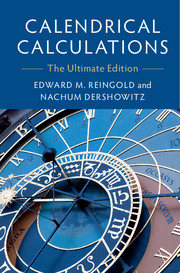Book contents
- Frontmatter
- Dedication
- Contents
- List of Frontispieces
- List of Figures
- List of Tables
- List of Calendar Functions
- Abbreviations
- Mathematical Notations
- Preface
- Credits
- License and Limited Warranty and Remedy
- 1 Calendar Basics
- I Arithmetical Calendars
- II Astronomical Calendars
- III Appendices
- A Function, Parameter, and Constant Types
- B Cross References for Functions and Constants
- C Sample Data
- D Lisp Implementation
- Index
- Envoi
C - Sample Data
from III - Appendices
Published online by Cambridge University Press: 22 March 2018
- Frontmatter
- Dedication
- Contents
- List of Frontispieces
- List of Figures
- List of Tables
- List of Calendar Functions
- Abbreviations
- Mathematical Notations
- Preface
- Credits
- License and Limited Warranty and Remedy
- 1 Calendar Basics
- I Arithmetical Calendars
- II Astronomical Calendars
- III Appendices
- A Function, Parameter, and Constant Types
- B Cross References for Functions and Constants
- C Sample Data
- D Lisp Implementation
- Index
- Envoi
Summary
I admit that it is not farfetched that I might err, that some analysis or source elude me—this is not a big matter. I am elated that I am being scrutinized so carefully; whosoever does so merits reward and gratitude. For either he is correct in his critique and I benefit thereby, or, if he is in error, he will derive benefit.
Maimonides: Letter to Joseph ben Judah Ibn Simeon, to whom The Guide to the Perplexed was addressed (1191)To aid the reader interested in implementing our functions, we give two sets of tables in this appendix. First, we give tables of 33 dates from the years -1000 to 2100 with their equivalents on all the calendars discussed in the book. For each date we also give the dates of Easter that same year (Orthodox, Gregorian, and astronomical); the ephemeris correction, equation of time, and solar longitude at 12:00:00 u.t.; the moment of the next solstice or equinox (u.t.); the standard times of astronomical dawn in Paris, astronomical midday in Tehran, and astronomical sunset for Jerusalem; the lunar longitude, latitude, and altitude at 00:00:00 u.t.; the moment of the next new moon (u.t.), and the standard times of moonrise and moonset inMecca. At the bottom of each column in the tables is the equation number and corresponding page of the function used to compute that column. Changes in the hardware and software since the preparation of the third edition have caused minor changes in some sample values compared with that edition; the revision of what we called the “future Bahá’í calendar” (now the astronomical calendar) has caused significant changes to some of those sample values. The second set of tables gives the Gregorian dates in 2000-2103 of many holidays and other calendrical events as calculated by the functions in this book.
All dates and values given in this appendix are as computed by our functions and hence may not represent historical reality; furthermore, some dates are not meaningful for all calendars. Though times are reported down to the second, the astronomical algorithms that we use do not promise such accuracy.
- Type
- Chapter
- Information
- Calendrical CalculationsThe Ultimate Edition, pp. 445 - 468Publisher: Cambridge University PressPrint publication year: 2018

